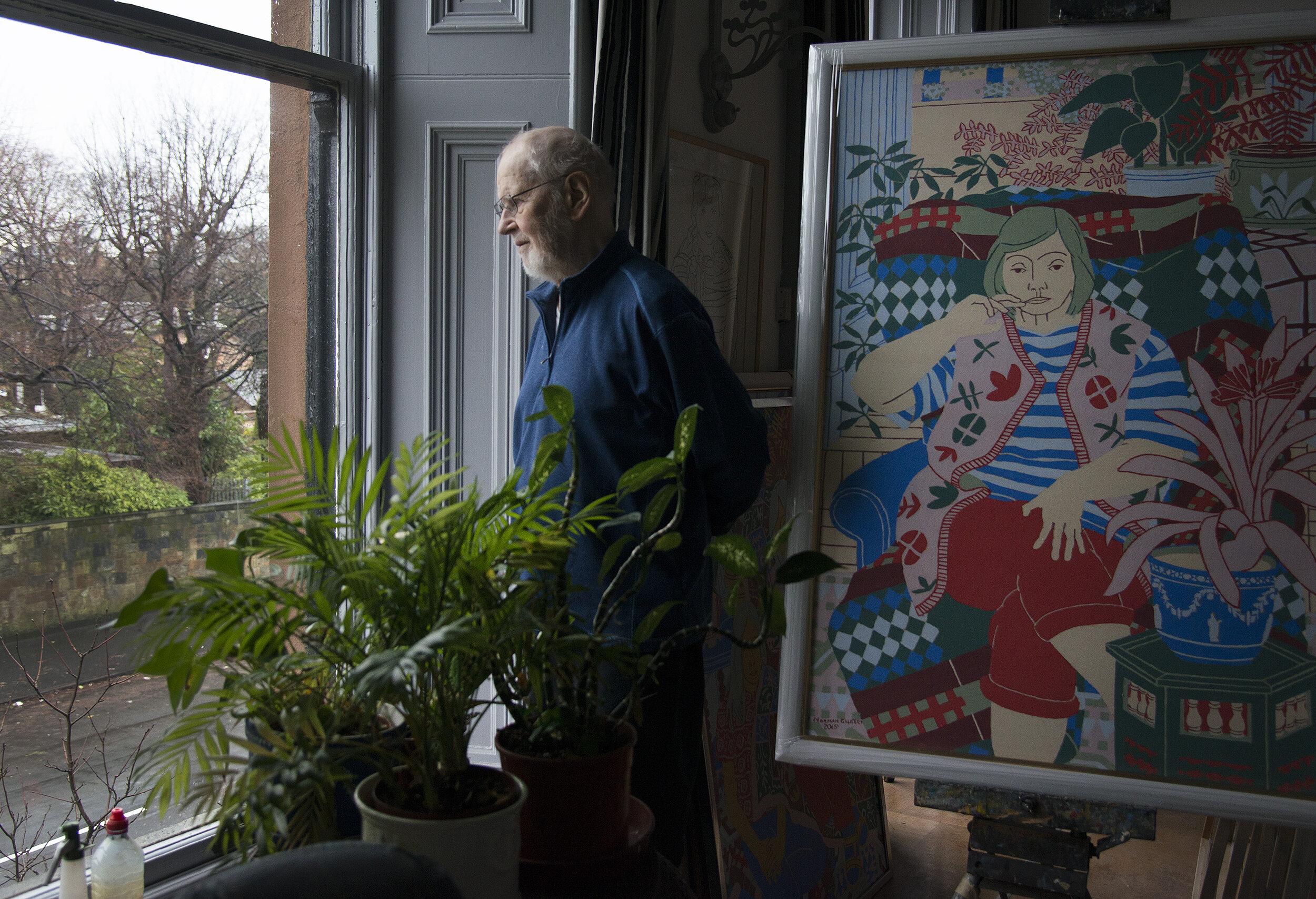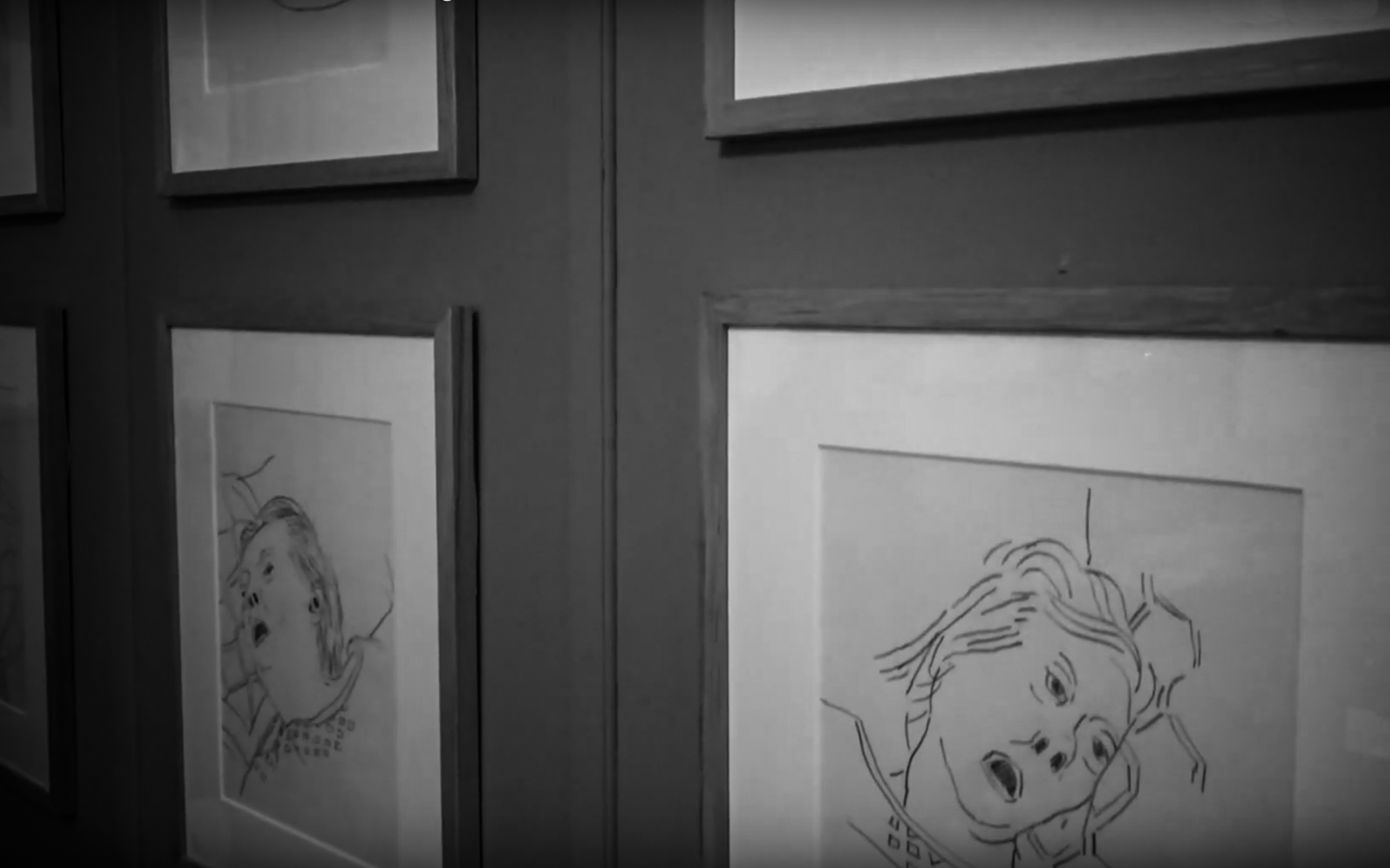
Drawing to a Close
Norman's wife, Pat, died of a stroke in 2016, six years after she was diagnosed with dementia. In her last days in hospital, Norman drew her, as he had so many times before. Here, writing in 2018, Mark Gilbert explains the personal and broader significance of these most intimate drawings.
My mum, Pat Gilbert, died at age 86, on the 3rd of August, 2016, the day before my parents’ 65th wedding anniversary. Diagnosed with Alzheimer’s Disease in 2010, my mum had a massive stroke and was taken to the hospital where she lay unresponsive for the last week of her life. As my dad, artist Norman Gilbert, kept vigil by her bedside he started to draw her, as he had done countless times before.
My parents met as students at Glasgow School of Art. Raised by artists, I have dedicated over 20 years to exploring, through portraiture, the experiences of patients and caregivers. What I have studied through arts-based research, my dad learned firsthand through lived experience: portraiture can allow artists, sitters and viewers to engage with illness, recovery and care in ways that can be transformative, instructive, and healing.
Woman with Scarf
Charcoal on Paper, 54 x 41 cm, 1992
Girl Getting into Bed
Oil on Board, 56 x 46 cm, 1954
While I worked with participants in makeshift studios in clinics and busy hospitals, Dad quietly maintained his own, more solitary painting practice in his home studio in Glasgow. He created meticulous, vividly coloured pictures that joyfully used pattern and line to create form and depth. Dad painted Mum more than anyone. Although initially depicted on her own, over the decades, Mum remained a constant presence in Dad’s pictures, and was most often pictured alongside my three older brothers and myself.
After Mum’s dementia diagnosis, Dad pictured Mum on her own again, in vibrant oil paintings created from numerous drawings he made as she sat with him. These later drawings testify to both her growing frailty and their ability, in many ways, to carry on very much as they had done before. Dad brought breakfast to mum’s bedside each morning after having his on his own. After she got up and dressed, they had a coffee together. When Dad worked in his upstairs studio, Mum would sit reading the newspapers. They had lunch together every day and met up in the afternoons for another coffee, a kitkat, and the crossword.
Pat II
Oil on board, 86 x 122 cm, 2013
Although Mum’s dementia is not overtly referenced, awareness of the context of these post-diagnosis portrayals of Mum establishes them as not only a powerful visual record of an artist-sitter or husband-wife relationship but also a powerful visual testament to an ever-evolving patient-caregiver relationship. In the context of Dad’s overall output, these pictures sustain the optimism and pleasure in color and pattern that saturates all of his work. The later pictures of Mum testify to the fluid roles that we are all asked to play at some point in our lives when we care for those we love and fall ill ourselves.
Pat I (Hands)
Pencil on Paper, 29.5 x 38 cm, 2016
Pat III
Pencil on Paper 38 x 29.5 cm, 2016
When Mum suffered her stroke, the physicians informed Dad that she would not recover. They were fortunate that the hospital gave them a room to themselves. Mum was treated judiciously, for pain. Dad stayed by her side. He drew and slept in a reclining chair. In an interview Dad carried out with a close family friend, a week after Mum died, he was able to reflect on that final week with Mum and the drawings (Robbins, Gilbert 2019). Dad said he had few qualms about drawing Mum; he just hoped that he could “do it justice.” Reflecting on his first, cautious drawing of Mum’s hands, and especially the hand affected by stroke, he said, “But the one [hand] that the stroke had affected pretty well remained in the same position all the time for the whole week. Even when the nurses turned her round the other way, her hand more or less remained the same ... somehow it is terribly evocative.”
Pat VI
Pencil on Paper, 38 x 29.5 cm, 2016
Pat VII
Pencil on Paper, 38 x 29.5 cm, 2016
Drawing helped him focus on what was familiar at a time of great uncertainty. When interviewed, he initially described the drawings purely in terms of the patterns on the sheets, the checks on the towel placed under Mum’s face and the design printed on her NHS nightdress. These were visual elements he was comfortable with and could literally draw on as he’d always done, to seek some semblance of order and coherence.
Pat IX
Pencil on Paper, 29.5 x 38 cm, 2016
Pat XI
Pencil on Paper, 29.5 x 38 cm, 2016
When considering why he made the drawings, he explained, “It is what I do. I mean some people might have read a book … It didn’t enter my head to take a book. But, it did enter my head to take the sketch book … I could have put on the radio, or a television. I didn’t put that on for the whole time.” He continued, “I didn’t think there was anything strange about doing the drawings. It was just something I have spent my life doing … It actually took my mind off completely what I was doing. One of the doctors did come and saw that I was drawing, and I said “it is alright. It just keeps me sane.” He explained, “when I was doing the drawings, I forgot! I was just drawing Pat again … I had drawn her thousands of times before.” It was, for him, normal. He acknowledged how the drawings may differ in relation to the other pictures he had made of Mum and poignantly stated: ‘I think they are separate from [the other work]. I can’t show them to her … [I] can’t ask her what she thought of them. At one point I did say, there’s no point in doing them because I can’t show her them.”
Dad regards these drawings as the best pictures he has made. In the last drawing, we witness Dad struggling, maybe more than ever to express and record what has happened, what he is seeing, and weave this all into what he was experiencing and feeling. When I look at the last drawing, I can see there has been a shift. It looks different from the others, more awkward, maybe less confident, but still intensely searching, making sense. Dad remarked, “It’s not the best drawing I have ever done. But, perhaps it’s got a significance that the others haven’t.” In remembering the making of the final drawing of my mum, Dad recalled,
“At the end, I was sitting in the chair beside her, and I was covered up with the hospital blanket. And, I woke up at about two o’clock in the morning, and felt her arm. And, it was colder than usual. And, I looked at her chest, and it was going up and down slowly. So, I knew she wasn’t dead or anything. But, then I looked at her mouth. Her mouth was really closed compared with what it usually was. But she was still breathing. But, very slowly. And, then, I started counting between each breath. And, she would breathe, and then I could count, one, two, three, up to ten before she would take another breath so that there were long gaps between each breath. And, I sat doing that for about fifteen or twenty minutes, just counting between each breath. And, then the last breath, she just took a breath and then there was a wee gurgle … and then there were no more breaths after that. And, I thought I’ve drawn her in every position up until now, so I will need to draw her this way too. And, I did. So, the first thing I did after she died … was draw her again. And, then once I had done that, I opened the door and one of the [orderlies] was sitting outside the door … and, she said ‘I will go and get the nurse’. And, then I came home at about three o’clock in the morning.”
Pat XVI (The Last Drawing)
Pencil on Paper, 29.5 x 38 cm, 2016
Looking at the last drawing, Dad reflected, “perhaps people would find that it was strange that I was able to do it under the circumstances, but, it wasn’t a difficult decision to make. I could have just gone and called a nurse. But I thought no, I have another drawing to do.” When we are confronted with images like this, we are invited to reflect on aspects of life that we may fear most. Engaging with such experiences through drawings can enable viewers to build a picture of what happened that week. These images continue to be a fulcrum around which Dad and I are able to talk about Mum and her life.
Those who knew my mum as an art teacher have shared that she helped and inspired so many to articulate themselves through their art. She shared her belief that the arts in all their forms can help people live life with passion, compassion and care. Her wisdom lives on in her images as she continues to inspire people to find the positive, constructive and even beautiful moments, thoughts and experiences in challenging times.
Chair II
Oil on Board, 86 x 122 cm, 2017
As a collection, Dad’s drawings can help us all consider our relationship to giving and receiving care, our appreciation of health and illness and our understandings of dementia, death and dying. These pictures invite people to talk openly about death and bereavement. The compassion that deepened Dad’s awareness and attention to Mum that was fundamental to the creation of these drawings could be vital to softening the medical gaze. Norman Gilbert’s works transform deeply private experiences into shared comprehensions of love, caregiving, dementia, end of life and bereavement. Ultimately, these drawings are an intimate record of the last days my dad spent with his wife, my mum.

The Exhibition
In November 2018, the End of Life Studies Group exhibited the series
The exhibition was shown at the Yellow Door Gallery in Dumfries as part of the UK-wide Being Human festival.
November 2018
